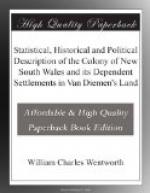The extent to which capital might thus be invested is boundless; since if the breeder did not possess as much land as would feed the number of sheep that he might wish to keep, he would only have to send his flocks beyond the limits of colonization, and retire with them as the tide of population approached. His hurdles, and the rude huts or tents of his shepherds, might always be removed with very little difficulty and expense; and if his and his neighbours’ flocks should happen to come into contact, such is the immensity of the wilderness which would lie before him, that he might exclaim in the language of Abram to Lot: “Let there be no strife I pray thee between me and thee, and between my herdsmen and thy herds-men; for we be brethren. Is not the whole land before us? Separate thyself I pray thee from me. If thou wilt take the left hand, then I will go to the right; or if thou depart to the right hand, then I will go to the left.” Such, should any of these disputes occur, might always be their amicable termination. There is, and will be for ages to come, whatever may be the extent of emigration, more land than can possibly be required. The speculation, therefore, of growing wool can meet with no checks from the want of pasturage in the colony, and it is equally improbable that it can be impeded by the want of a market in this country. It is well known that the Saxon wool cannot be sold under the present prices without loss to the growers. The severity of the climate of Saxony, renders it indispensable for the sheep-holders to take a variety of precautions which are not only useless in this colony, but would even prove highly detrimental to the constitution of this valuable animal. In the former country, the flocks are kept almost invariably in sheds of a very costly construction both by day and night, and are fed almost wholly upon hay; in the latter, they are




